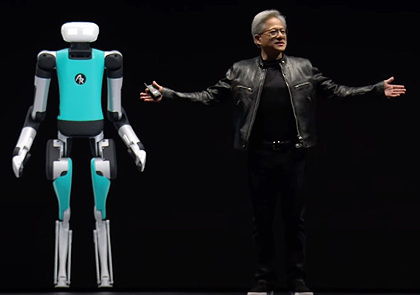- Home » News » World News
Nvidia unveils multiple robot technologies

The chip-maker and software developer Nvidia has announced a slew of developments aimed at advancing robotics and automation technologies at its annual GTC (GPU Technology Conference) event in California. These included a model for humanoid robots called Gr00t (Generalist Robot 00 Technology), as well as a powerful new computer, called Jetson Thor, also aimed at humanoid applications.
“Building foundation models for general humanoid robots is one of the most exciting problems to solve in AI today,” Nvidia’s founder and CEO, Jensen Huang, told the audience of 11,000. “The enabling technologies are coming together for leading roboticists around the world to take giant leaps toward artificial general robotics.”
Nvidia is building an AI platform for humanoid robot developers including Agility Robotics, Apptronik, Boston Dynamics, Figure AI, Fourier Intelligence, Unitree Robotics and Xpeng Robotics.
The company also announced a collection of pre-trained models, libraries and reference hardware for robot developers. Its Isaac Manipulator platform offers modular AI capabilities for robotic arms, as well as GPU-accelerated libraries. It can speed up path planning 80-fold, and will allow developers to automate more robot tasks. Early adopters include Yaskawa, Universal Robots, PickNik Robotics, Ready Robotics and Franka Robotics.
A second platform, called Isaac Perceptor, offers multi-camera, 3D surround-vision capabilities, helping to improve efficiency and worker safety for AMRs (autonomous mobile robots), as well as cutting error rates and costs.
In total, Nvidia made around 40 separate announcements at GTC, including what it describes as “the world’s most powerful chip”, containing 208 billion transistors. The chip, called Blackwell, is aimed at applications such as deep learning, engineering simulation and AI.
“Generative AI is the defining technology of our time,” Huang told the audience during his two-hour talk. “Blackwell is the engine to power this new industrial revolution. Working with the most dynamic companies in the world, we will realise the promise of AI for every industry.”
Huang also showed how digital twins can simulate, test and refine large-scale, real-time AIs before rolling them out in industrial settings, saving considerable time and costs. He demonstrated a digital twin of a 100,000ft2 warehouse containing dozens of simulated workers and multiple AMRs, vision AI agents and sensors. Each AMR, running the Isaac Perceptor multi-sensor stack, was processing visual information from six sensors, all simulated in the digital twin.
Simultaneously, Nvidia’s Metropolis platform for vision AI created a map of worker activity across the warehouse, combining the data from 100 simulated ceiling-mounted cameras with multi-camera tracking. Such occupancy maps will help to optimise AMR routes.

In other announcements at GTC, Nvidia revealed that it:
• Is working with Teradyne Robotics, the owner of the cobot developer Universal Robots (UR) and the AMR specialist MiR to bring AI capabilities to their technologies. At the GTC, UR demonstrated an AI-powered autonomous inspection system using Nvidia’s Jetson AGX Orin edge AI computer that makes robot path planning 50-80 times faster that today’s systems. MiR is using the same module in a new pallet jack AMR that uses 3D vision to identify, pick up and deliver pallets “with unprecedented precision”, even in dynamic and complex environments.
• Is collaborating with Rockwell Automation to accelerate a next-generation industrial architecture. This will include integrating Nvidia’s Omniverse Cloud APIs with Rockwell’s Emulate3D software to offer data interoperability, live collaboration, and physically-based visualisations for designing, building and operating industrial-scale digital twins of plants. Rockwell is also using Nvidia’s robotics platform for edge AI to help deliver AMR and process automation applications to industrial users.
• Is deepening its collaboration with Siemens and linking its Omniverse Cloud APIs to Siemens’ Xcelerator platform to help create the industrial metaverse and increase the use of AI-driven digital twin technologies. At the GTC, Siemens and Nvidia demonstrated how generative AI can revolutionise the visualisation of complex data, and showcased how the Korean shipbuilder Hyundai is using the technology to design and build vessels.
• Has produced five new Omniverse Cloud APIs that will allow industrial software developers to integrate Omniverse technologies into design and automation applications for digital twins, or simulation workflows for testing and validating machines such as robots. Developers using the APIs include Ansys, Cadence, Dassault Systèmes, Hexagon and Microsoft.
• Is developing a 6G research platform that will give researchers a novel approach to develop the next phase of wireless technology. The 6G Research Cloud platform is open, flexible and interconnected, allowing researchers to advance AI for Ran (radio access network) technologies. It will allow them to accelerate the development of 6G technologies to connect devices with cloud infrastructures, laying the foundation for a “hyper-intelligent” world supported by collaborative robots, autonomous vehicles, and a variety of extended reality and immersive experiences.
Nvidia: Twitter LinkedIn Facebook





